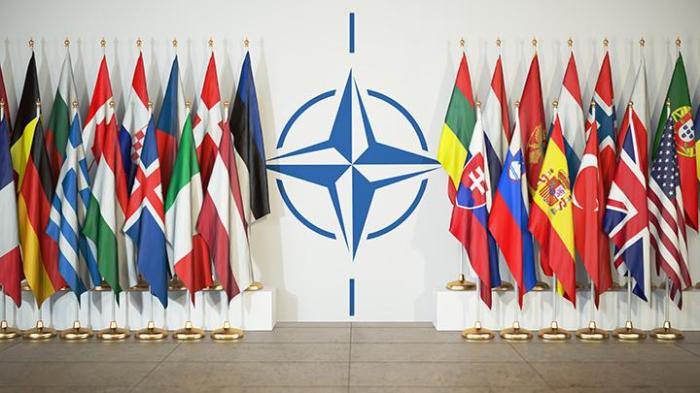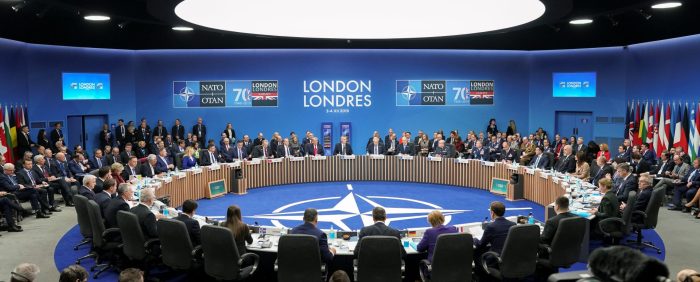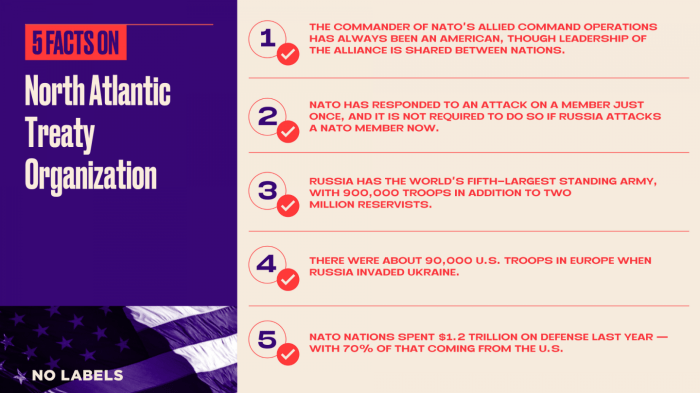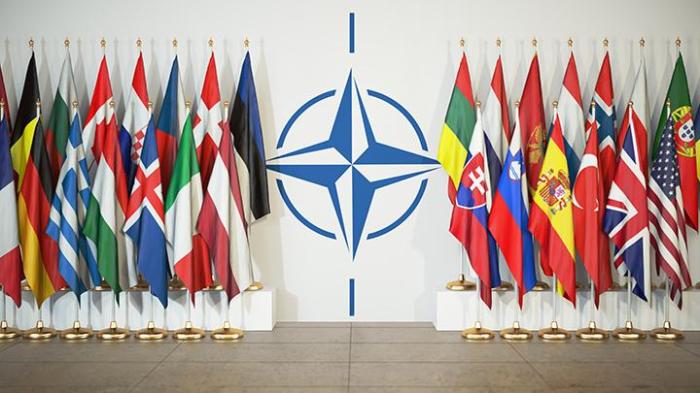
The Need for NATO: A Global Security Anchor
The Need for NATO takes center stage in a world where global security is constantly evolving. From the ashes of World War II, NATO emerged as a beacon of collective defense, uniting nations against the backdrop of the Cold War.
Today, the alliance remains vital, facing a new era of challenges that demand its continued relevance.
This blog delves into the historical context, evolution, and strategic importance of NATO. We’ll explore how the alliance has adapted to changing threats, from the Cold War’s ideological divide to the rise of terrorism, cyberwarfare, and authoritarianism. We’ll also examine NATO’s role in international cooperation, its partnerships with non-member countries, and its ongoing operations in various regions around the globe.
Historical Context of NATO: The Need For Nato
NATO’s genesis lies in the turbulent aftermath of World War II, a period marked by the rise of the Cold War and the emergence of two superpowers, the United States and the Soviet Union, vying for global dominance. The formation of NATO was a direct response to the perceived threat posed by the Soviet Union and its expansionist policies in Eastern Europe.
NATO’s commitment to collective defense is crucial in a world facing numerous threats, but we can’t ignore the impact of military activities on the environment. The production and use of weapons, along with the deployment of troops and equipment, can have significant consequences, from air and water pollution to habitat destruction.
Understanding the effects on the environment is vital as we strive to maintain global security while minimizing our environmental footprint. By adopting sustainable practices and prioritizing environmental considerations, NATO can ensure its operations are both effective and responsible.
The Geopolitical Landscape of Post-War Europe
The end of World War II left Europe divided and vulnerable. The Soviet Union, having emerged victorious from the conflict, exerted its influence over Eastern Europe, establishing communist regimes in countries like Poland, Czechoslovakia, and Hungary. This expansionist policy, known as the “Iron Curtain,” created a stark divide between the West and the East, fueling fears of Soviet aggression in Western Europe.
The Origins of NATO
In the face of this growing Soviet influence, the United States and its Western allies recognized the need for a collective security arrangement to deter Soviet expansionism. The North Atlantic Treaty Organization (NATO) was established on April 4, 1949, with the signing of the North Atlantic Treaty in Washington, D.C.
The treaty, a cornerstone of the alliance, Artikeld the principles of collective defense, stating that an attack on one member would be considered an attack on all.
The Initial Membership and Strategic Objectives of NATO
NATO’s founding members included Belgium, Canada, Denmark, France, Iceland, Italy, Luxembourg, the Netherlands, Norway, Portugal, the United Kingdom, and the United States. These nations, united by shared democratic values and a commitment to containing Soviet expansionism, sought to deter Soviet aggression and safeguard their collective security.NATO’s initial strategic objectives during the Cold War were multifaceted:
- To deter Soviet aggression and prevent the spread of communism in Western Europe.
- To maintain a balance of power between the West and the East.
- To provide a framework for collective defense and military cooperation among its members.
- To promote political and economic cooperation among its members.
NATO’s formation marked a significant shift in the geopolitical landscape of Europe, ushering in an era of Cold War tensions and military preparedness. The alliance’s commitment to collective defense and its unwavering stance against Soviet expansionism served as a key deterrent to Soviet aggression, helping to preserve peace and stability in Western Europe for decades.
NATO’s Evolution and Adaptability
NATO, the North Atlantic Treaty Organization, has undergone significant transformations since its inception in 1949, reflecting the evolving global security landscape. From its initial focus on containing Soviet expansion during the Cold War, NATO has adapted to address new threats and challenges, demonstrating its resilience and adaptability.
NATO’s Role and Mission During the Cold War
During the Cold War, NATO’s primary mission was to deter Soviet aggression and protect its members from a potential attack. The organization’s strategy was based on collective defense, where an attack on one member was considered an attack on all.
NATO’s existence is a testament to the need for collective security in a world facing complex threats. However, understanding the nuances of this organization requires critical thinking and a balanced media landscape. Unfortunately, the media often succumbs to sensationalism and biases, which can distort public perception.
It’s crucial to be aware of how the media shapes narratives, especially when it comes to sensitive topics like international security. For a deeper dive into how the media can be manipulated, check out this insightful article on pushing the media right.
Ultimately, a well-informed public is essential for ensuring NATO’s effectiveness in safeguarding global peace and stability.
This principle, enshrined in Article 5 of the North Atlantic Treaty, served as the cornerstone of NATO’s deterrence strategy. NATO’s activities during this period included:
- Maintaining a strong military presence in Europe, with substantial deployments of troops and equipment.
- Developing and implementing military plans to counter a potential Soviet attack.
- Engaging in diplomatic efforts to reduce tensions with the Soviet Union, such as the Strategic Arms Limitation Talks (SALT).
- Providing military assistance to non-NATO countries, particularly in the context of the Cold War.
NATO’s Current Objectives
Since the end of the Cold War, NATO has shifted its focus to address a wider range of security challenges, including:
- Combating terrorism and transnational crime.
- Promoting stability and security in the Balkans and the Middle East.
- Responding to the rise of new threats, such as cyberattacks and hybrid warfare.
- Strengthening partnerships with non-NATO countries, particularly in the Asia-Pacific region.
Challenges and Opportunities
NATO has faced numerous challenges throughout its history, including:
- The end of the Cold War, which led to a period of uncertainty and a reassessment of NATO’s purpose and role.
- The expansion of NATO eastward, which raised concerns from Russia and other countries.
- The rise of new threats, such as terrorism, cyberattacks, and hybrid warfare, which have required NATO to adapt its strategies and capabilities.
- The need to maintain a strong military presence while also engaging in diplomacy and dialogue to promote stability and security.
Despite these challenges, NATO has also had significant opportunities for growth and adaptation, including:
- The ability to focus on new security challenges and threats, such as terrorism and cyberattacks.
- The opportunity to expand its partnerships and build stronger relationships with non-NATO countries.
- The potential to play a more active role in promoting stability and security in regions outside of Europe.
NATO’s Adaptation to Changes in the Global Security Environment, The need for nato
NATO has demonstrated a remarkable ability to adapt to changes in the global security environment. Following the end of the Cold War, NATO shifted its focus from containing Soviet expansion to addressing a wider range of security challenges, including terrorism, transnational crime, and the rise of new threats.NATO’s adaptation has been evident in several key areas:
- Strategic Concepts: NATO has revised its strategic concepts to reflect the changing security environment. For example, the 1999 Strategic Concept emphasized the importance of partnerships and cooperation with non-NATO countries, while the 2010 Strategic Concept focused on the challenges posed by terrorism, cyberattacks, and hybrid warfare.
- Military Capabilities: NATO has invested in developing new military capabilities to address emerging threats. This includes investing in cyber defense, counterterrorism, and rapid reaction forces.
- Partnerships: NATO has expanded its partnerships with non-NATO countries, including countries in the Asia-Pacific region. These partnerships have helped to enhance NATO’s ability to address global security challenges and promote stability and security.
- Outreach and Diplomacy: NATO has engaged in a more active outreach and diplomacy strategy, particularly in regions where its interests overlap with those of other countries. This has helped to build trust and cooperation with non-NATO countries and address shared security concerns.
The Strategic Importance of NATO Today

NATO’s enduring relevance in the 21st century is undeniable, as the alliance faces an increasingly complex and volatile security environment. While the traditional threat of large-scale conventional warfare between major powers has diminished, new challenges have emerged, requiring NATO to adapt and evolve its strategies to address these evolving threats.
The Evolving Security Landscape
The post-Cold War era has witnessed a resurgence of authoritarianism, fueled by the rise of nationalist and populist movements. This trend has been accompanied by increased interstate competition, territorial disputes, and the proliferation of advanced weapons technologies. Moreover, the rise of non-state actors, such as terrorist organizations and cybercriminals, has significantly complicated the security landscape.
NATO’s existence is often debated, with some arguing its necessity in a world of shifting power dynamics. Understanding the role of NATO requires delving into the broader context of global politics, particularly the rise of neoliberalism, a philosophy that emphasizes free markets and limited government intervention.
For a deeper understanding of this complex ideology, check out a primer on neoliberalism , which provides a comprehensive overview of its principles and implications. Ultimately, the question of NATO’s relevance is tied to the evolving global landscape, shaped by the interplay of economic, political, and ideological forces.
NATO members face a multifaceted array of threats, ranging from traditional military aggression to cyberattacks, hybrid warfare, and the spread of disinformation.
NATO’s Role in Collective Defense and Deterrence
NATO’s core purpose remains collective defense, based on the principle of “one for all and all for one.” This principle ensures that an attack against one member is considered an attack against all. The alliance’s collective defense posture is reinforced through the deployment of military forces, joint exercises, and the development of advanced military capabilities.
This collective defense framework acts as a powerful deterrent, discouraging potential adversaries from engaging in aggressive actions.
NATO’s Ongoing Operations and Initiatives
NATO is actively engaged in various operations and initiatives across the globe, demonstrating its commitment to international security.
- In the Middle East, NATO has played a significant role in countering terrorism, particularly through its support for the Afghan government in its fight against the Taliban and its participation in the Global Coalition Against Daesh.
- In the Balkans, NATO has been instrumental in promoting stability and security, contributing to the peaceful resolution of conflicts and supporting the development of democratic institutions.
- NATO’s efforts extend beyond traditional military operations. The alliance has actively addressed the challenges of cyberwarfare and hybrid warfare, investing in cyber defense capabilities and promoting international cooperation to combat these threats.
The Importance of Adaptation and Innovation
In an era of rapid technological advancements and evolving security threats, NATO must continuously adapt and innovate to remain effective. The alliance is actively exploring new technologies and strategies to enhance its capabilities, including artificial intelligence, robotics, and advanced cyber defense systems.
Moreover, NATO is working to strengthen its partnerships with non-NATO countries, recognizing the importance of collective action in addressing global security challenges.
The Role of NATO in International Cooperation

NATO is not an isolated entity. It recognizes the interconnectedness of global security and actively engages in international cooperation to address shared challenges. This engagement takes various forms, ranging from collaborative efforts with other international organizations to partnerships with non-member countries.
Cooperation with International Organizations
NATO’s cooperation with other international organizations, such as the United Nations and the European Union, is crucial for promoting global stability and security. These partnerships allow for a more comprehensive approach to addressing complex security issues.
- United Nations (UN):NATO and the UN share a common goal of maintaining international peace and security. They collaborate on various fronts, including peacekeeping operations, counter-terrorism efforts, and humanitarian assistance. For instance, NATO has provided logistical support to UN peacekeeping missions in Afghanistan and Kosovo.
NATO also contributes to the UN’s efforts in addressing global challenges like climate change and cyber security.
- European Union (EU):NATO and the EU have a strong partnership, particularly in the areas of security and defense. They work together to address common security challenges, such as terrorism, organized crime, and cyber threats. The EU’s Common Security and Defence Policy (CSDP) complements NATO’s efforts by providing a framework for EU member states to cooperate on defense and security issues.
For example, the EU has deployed military forces to support NATO operations in Afghanistan and Mali. The two organizations have also worked together to enhance maritime security in the Mediterranean Sea.
Impact of NATO’s Partnerships with Non-Member Countries
NATO’s partnerships with non-member countries contribute to global security by expanding its network of cooperation and fostering a more inclusive approach to security challenges.
- Individual Partnership Programs:NATO has established Individual Partnership Programs (IPPs) with over 40 countries worldwide. These programs tailor-made partnerships designed to enhance cooperation in areas such as military exercises, training, and information sharing. IPPs enable NATO to build relationships with countries that may not be ready for full membership but share common security interests.
- Partnership for Peace (PfP):The Partnership for Peace (PfP) is a broader framework for cooperation with non-member countries. Established in 1994, it offers a range of opportunities for cooperation, including military exercises, training, and dialogue. PfP has helped to strengthen security and stability in Europe and beyond.
For instance, PfP has played a role in supporting security reforms in countries like Ukraine and Georgia.
- Mediterranean Dialogue:The Mediterranean Dialogue is a platform for political and security dialogue between NATO and countries in the Mediterranean region. This dialogue aims to promote cooperation on shared security concerns, such as terrorism, migration, and maritime security. It has helped to build trust and understanding between NATO and countries in the region, fostering a more stable and secure Mediterranean environment.
NATO’s Role in Promoting Stability and Cooperation Beyond its Immediate Area of Operation
NATO’s commitment to global security extends beyond its immediate area of operation. The alliance recognizes that instability in one region can have repercussions for others. Therefore, NATO engages in efforts to promote stability and cooperation in regions beyond its immediate area of operation.
- Counter-Terrorism:NATO actively contributes to the global fight against terrorism. The alliance has deployed troops to Afghanistan to train Afghan security forces and to support the fight against al-Qaeda. NATO also engages in counter-terrorism efforts in other parts of the world, including through partnerships with non-member countries and through intelligence sharing.
- Cybersecurity:NATO has recognized the growing threat posed by cyberattacks and has taken steps to enhance its own cybersecurity capabilities and to work with other countries to address this challenge. The alliance has established a Cyber Defence Centre of Excellence in Estonia, which provides training and expertise to NATO members and partners.
NATO also works with the private sector to improve cybersecurity and to share information about cyber threats.
- Maritime Security:NATO plays a vital role in promoting maritime security, particularly in the Mediterranean Sea. The alliance has conducted naval operations to counter piracy and to support humanitarian efforts in the region. NATO also works with other countries to address maritime security challenges, such as illegal migration and human trafficking.
The Future of NATO

NATO, a cornerstone of transatlantic security since its inception in 1949, faces a complex and evolving landscape in the years to come. The alliance will need to navigate a multitude of challenges and opportunities, adapting its strategies and capabilities to maintain its relevance and effectiveness.
Challenges and Opportunities
The future of NATO will be shaped by a confluence of factors, including the evolving security environment, technological advancements, and the changing geopolitical landscape.
- Rising Tensions with Russia:The ongoing conflict in Ukraine has heightened tensions between NATO and Russia, leading to a significant increase in military spending and a more assertive posture from both sides. This dynamic will likely persist, requiring NATO to strengthen its deterrence and defense capabilities while seeking avenues for dialogue and de-escalation.
- China’s Growing Military Power:China’s rapid military modernization and assertive foreign policy have raised concerns within NATO about its potential to challenge the existing global order. The alliance will need to develop strategies to address China’s growing influence, including through enhanced cooperation with partners in the Indo-Pacific region.
- Technological Advancements:The rapid pace of technological advancements, particularly in areas such as artificial intelligence, cyberwarfare, and hypersonic weapons, presents both opportunities and challenges for NATO. The alliance will need to invest in new technologies and adapt its doctrines to effectively counter emerging threats while harnessing the potential of new technologies to enhance its capabilities.
- Challenges to Democracy and International Order:The rise of populism, authoritarianism, and misinformation poses a significant challenge to democratic values and the rules-based international order that underpins NATO’s security framework. The alliance will need to strengthen its resilience against these threats and promote democratic values both within its member states and beyond.
- The Need for Adaptability:NATO’s success in the future will depend on its ability to adapt to the evolving security environment. This requires a flexible and agile approach to defense planning, force posture, and operational concepts.
A Hypothetical Scenario: Adapting to Future Threats
Imagine a scenario where a major cyberattack disrupts critical infrastructure across several NATO member states, crippling communication networks, power grids, and financial systems. This event, potentially attributed to a state actor or a sophisticated non-state group, would highlight the vulnerability of modern societies to cyberattacks and underscore the need for robust cyber defense capabilities.
NATO, recognizing the gravity of the situation, would respond by:
- Strengthening Cyber Defenses:The alliance would invest heavily in enhancing its cyber defense capabilities, including through the development of new technologies, the establishment of dedicated cyber units, and the strengthening of cyber cooperation between member states.
- Developing a Collective Cyber Deterrence Strategy:NATO would work to develop a collective cyber deterrence strategy, sending a clear signal to potential adversaries that attacks against member states would be met with a swift and decisive response.
- Promoting International Cooperation:The alliance would work to strengthen international cooperation in the field of cybersecurity, collaborating with partners and organizations to share information, develop best practices, and build capacity.
NATO Expansion: Arguments for and Against
The issue of NATO expansion has been a source of debate for decades. The following table presents arguments for and against expanding NATO’s membership in the future:






